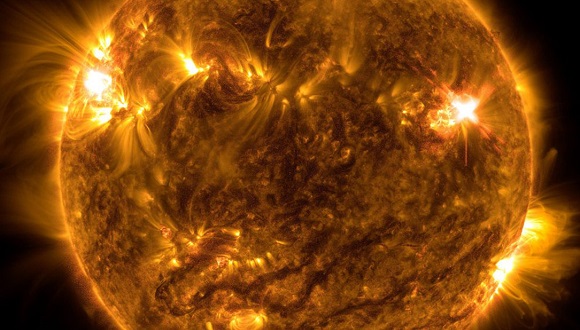Although the cables are no longer susceptible to solar storms, their repeaters, and if one of them is disconnected, some of the cables will be disconnected. Photo: Russia Today
Activity from the Sun’s surface can come in the form of high-speed solar winds, which have the potential to produce mild to moderate geomagnetic storms.
NASA announced that the Solar Dynamics Observatory captured last Sunday as the Sun launched a powerful flare of electromagnetic energy into space, peaking at 08:25 GMT. He also pointed out that these explosions, originating from the sun’s surface, are classified as class X1, which can cause serious damage to radio signals and power grids, as well as pose a risk to spacecraft.
This is because recent solar activity can reach Earth in the form of high-speed solar winds, which have the potential to produce mild to moderate geomagnetic storms, including producing auroras seen in the planet’s polar regions. But can a solar storm leave Earth’s inhabitants without an internet connection? And if this is possible, what are the chances of this happening?
According to physicist at the University of Reading (UK), Mathew Owens, quoted this Sunday by Live Science, this “could happen, but would require a giant solar storm.” However, he stressed that this scenario was “impossible”, although he stressed that it was “most likely that the power grid would be shut down”, as geomagnetic energy could disrupt the electrical conductors of the transmission lines that transport electricity from power stations to homes.
On March 13, 1989, a power outage was recorded in Quebec (Canada) during one of these solar events, which lasted approximately 12 hours. A more recent case of the solar storm effect was in February this year, when about 40 Starlink satellites were not in use, because SpaceX was unable to corroborate space weather forecasts.
According to Axios portal specialist Miriam Kramer, this happens because the solar flare hits the Earth’s magnetic field. This causes the atmospheric resistance to increase by at least 50%, so the satellite returns to Earth shortly after being placed in orbit.
The destruction of some of these satellite devices in no way jeopardizes the future of the Internet. However, it could collapse if a geomagnetic storm disrupts a fiber-optic cable that lies beneath the ocean. The cables are equipped with repeaters placed at a distance of between 50 to 145 kilometers between them to increase the signal intensity.
Although the cables are no longer susceptible to solar storms, their repeaters, and if one of them is disconnected, some of the cables will be disconnected. It means “internet apocalypse”. This expected possibility will be reflected in the disruption of various services connected to the network, from supply chains to stock markets.
One way to protect worldwide Internet access in the face of possible large-scale solar storms is to strengthen power lines, satellites and submarine cables to prevent them from being overloaded by high currents. Another approach is to find better methods for the prevention of long-term geomagnetic storms, although they are difficult to predict.
Currently, solar storms can be forecast for up to two days before they impact the planet based on sunspot activity on the Sun’s surface. But the technology to help scientists track these events in the same way doesn’t yet exist. they are expected to develop techniques to prevent or reduce future occurrences.
(Taken from Russia Today)

“Entrepreneur. Internet fanatic. Certified zombie scholar. Friendly troublemaker. Bacon expert.”







